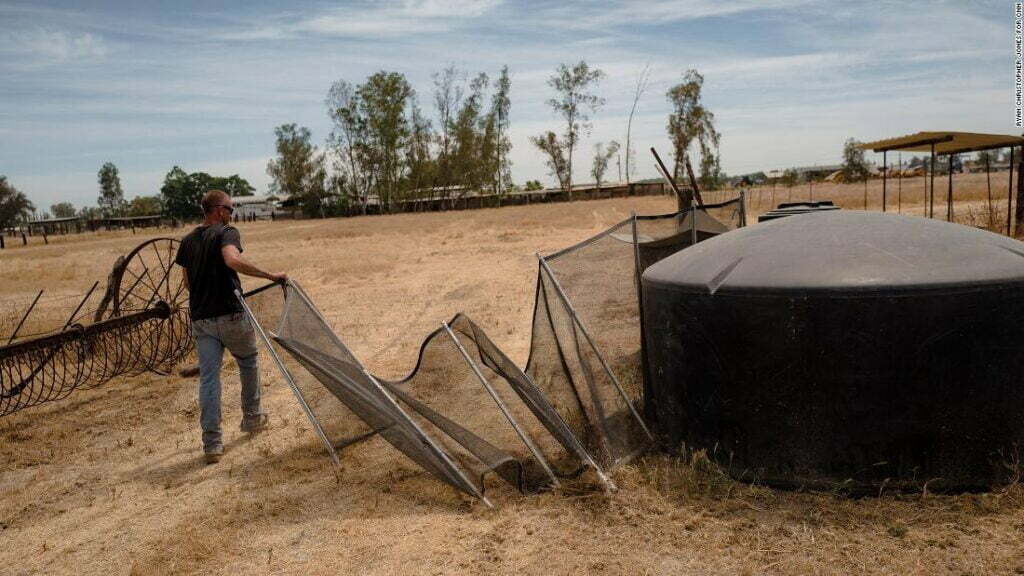“Central California is dying,” says lifetime California resident and farmer, Gary Biggs. “We’re becoming a wasteland. A hot and dry wasteland.”
Biggs, 72, grew up on a prosperous farm in West Goshen. He remembers tending orange and pecan trees while his father raised cows and sheep and grew alfalfa. Today, the eight-acre plot that has since been passed down to his son Ryan is much different than the flourishing orchard he remembers. “Now, it’s all dirt.”
As years of drought and over-pumping began to impact the region’s natural groundwater sources, Ryan and his family started to rely on government cistern programs and the kindness of their neighbors. Now, the family is forced to bring in water from outside sources to drink, cook, and shower. They drive into town to do laundry.
“God forbid I don’t know how long this drought is gonna go on,” laments Biggs. “Believe it or not, climate change is here and California is a real poster child for it.”
Biggs and his family are among many rural Californians who have long depended on groundwater sources that have in recent years dried up. And with hot summer weather approaching, the possibility increases that more California families will run out of water.
California Governor Gavin Newsom (D) has begged businesses and urban residents to cut water usage, but there is little he can do without legislation. Last week, he asked residents of southern California cities to cut usage by 35% to avoid a ban.
Exacerbating the water shortage is the presence of nitrate and other contaminants in some drinking water systems. Nitrate, which comes from fertilizers used in farming, has no taste or smell. Consuming too much nitrate has been linked to a host of health problems including methemoglobinemia, nausea, headaches, abdominal cramps, and cancer.
In Ducor, an unincorporated region of Tulare County, residents blame over-pumping by agriculture and industry for the dwindling supply of groundwater and the presence of nitrate.
Another factor at play is the timing of the current drought, which impacted groundwater supplies before they recovered from a previous drought. And with climate trends leading to a decrease in wintertime precipitation, there has been far less snowmelt available to fill reservoirs, rivers, and groundwater systems in the spring.
“The first thing that’s important to understand is these communities have been historically disinvested in since the beginning,” argues Kelsey Hinton. ”They weren’t even included in general planning for the county, or considered viable communities that were going to continue to grow over time.”
Hinton works in the San Joaquin Valley region as the communications director for the Community Water Center – an organization advocating for affordable access to clean water. Water has historically been considered a ‘property right’ in the state of California, meaning residents can pump as much water from land they own as they like. But as drought conditions worsened and wells were deepened, water was removed faster than it could be replaced naturally.
To make matters worse, adds Hinton, there has been little oversight regarding the issuance of well-drilling permits.
Governor Newsom has attempted to address this issue with an executive order that prevents the issuance of well-drilling permits without a review of how future drilling could impact nearby residents, but it is unclear how long the order will last.
“We’re in this part of the state that is slowly dying, because no one’s taking us seriously,” says Biggs. “I tell my grandkids as soon as you get out, leave this area, go somewhere where there’s water, because this place is dying.”
According to experts, severe drought conditions may lead to a 50% decrease in California’s hydropower this summer.
Editor’s Note: Water flows uphill to money. The cities have historically rerouted water to themselves away from the formerly flourishing rural areas. California is mismanaging its water, much like it is mismanaging its power grid (frequent brownouts), its forest lands (frequent out of control forest fires), its homeless population (increasing and destroying quality of life), and much more. Now, they will find that all solutions to the water problem are very expensive.
Source:
As California’s big cities fail to rein in their water use, rural communities are already tapped out
